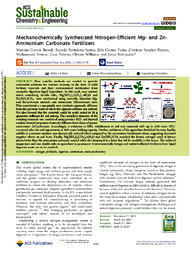Mechanochemically Synthesized Nitrogen-Efficient Mg- and Zn- Ammonium Carbonate Fertilizers.
Mechanochemically Synthesized Nitrogen-Efficient Mg- and Zn- Ammonium Carbonate Fertilizers.
Autoria: BRONDI, M. G.; BORTOLETTO-SANTOS, R.; FARIAS, J. G.; FARINAS, C. S.; AMMAR, M.; OLIVEIRA, C. R. de; WILLIAMS, C.; BALTRUSAITIS, J.
Resumo: New scalable methods are needed to provide sustainable solutions for nutrient recovery in the form of solid fertilizer materials and their environmental stabilization from anaerobic digestion liquid byproducts. In this work, two nutrient metal containing double salts, Mg(NH4)2(CO3)2·4H2O and Zn(NH3)CO3, were synthesized using naturally abundant Mgand Zn-carbonate minerals and ammonium (bi)carbonate salts. This constituted a conceptually new synthetic approach, different from the previous work in which the aqueous solution was utilized. We also showed that the materials could be easily scaled to 20 g quantities sufficient for soil testing. The crystalline structure of the resulting materials was confirmed using powder XRD and thermal analysis showed properties distinctly different from those of parent ammonium (bi)carbonates. Accordingly, a reduction in NH3 volatilization in soil was measured with up to 20% more NH4 recovered after the soil experiments at 80% water holding capacity. Further, inhibition of the agriculture-beneficial bacteria Bacillus subtillis in a nutrient medium was dramatically reduced when compared to the ammonium bicarbonate alone, suggesting decreased negative effects on soil biota. Finally, Mg(NH4)2(CO3)2·4H2O and Zn(NH3)CO3 matched the kinetic nitrogen need of lettuce plants better than the ammonium carbonate control while also keeping it in a form that will be available in the future. The utility of magnesium and zinc double salts in agriculture is paramount if environmentally benign and nutrient-efficient fertilizers from liquid digestate waste are to be enabled.
Ano de publicação: 2024
Tipo de publicação: Artigo de periódico
Unidade: Embrapa Instrumentação
Palavras-chave: Ammonium, Digestate, Mechanochemistry
Observações
1 - Por padrão são exibidas publicações dos últimos 20 anos. Para encontrar publicações mais antigas, configure o filtro ano de publicação, colocando o ano a partir do qual você deseja encontrar publicações. O filtro está na coluna da esquerda na busca acima.
2 - Para ler algumas publicações da Embrapa (apenas as que estão em formato ePub), é necessário ter, no celular ou computador, um desses softwares gratuitos. Sistemas Android: Google Play Livros; IOS: iBooks; Windows e Linux: software Calibre.
Acesse outras publicações
Acesse a Base de Dados da Pesquisa Agropecuária (BDPA) para consultar o acervo completo das bibliotecas da Embrapa.

